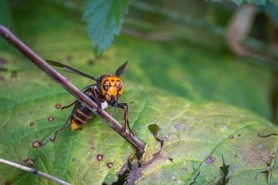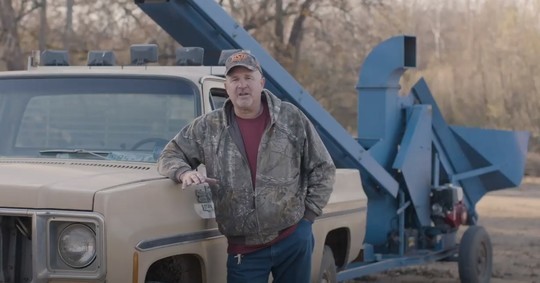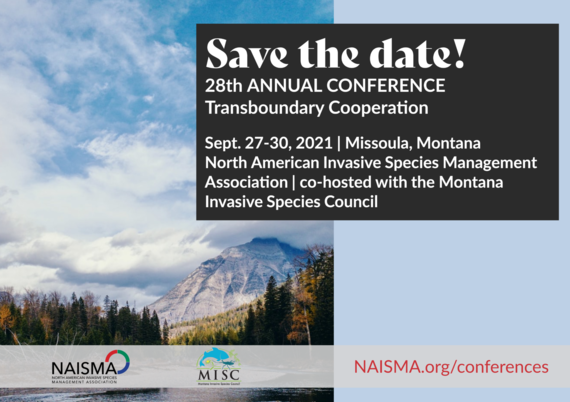|
The Invasive Species Bulletin provides you with all the latest news on invasive species in Montana and the region. Please let us know if you have any suggestions, contributions, questions, corrections, or comments. Email: scriswell@mt.gov
 USDA Encourages the Public to Protect Plants Against Invasive Pests in April
The U.S. Department of Agriculture Animal and Plant Health Inspection Service (APHIS) celebrates Invasive Plant Pest and Disease Awareness Month (IPPDAM) every year in April. Many invasive plant pests emerge in spring and summer. The principal objective of IPPDAM is to raise awareness about the importance of protecting plant health against the threat of invasive plant pests and diseases and making sure residents know how to spot and report 20 invasive “hungry pests” and reduce their spread.
Pig fighters without borders
An international working group hopes to make the fight against wild pigs a consistent one
Manitoba Co-operator | April 6
The fight against wild pigs will have a newly united front in Western Canada and the western United States, should recommendations published late last year by an international working group get their way.
Manitoba is among the provinces and states to throw its weight behind the body, which launched last year in an effort to take wild pig control to the next level...read more.

US and Canadian Entomologists Make Plans For 2021 Asian Giant Hornet Season
WA Dept. Ag. | March 15
OLYMPIA – The Asian giant hornet, an invasive pest that threatens pollinators and ignores international borders, is the focus of an international effort to eradicate it in the Pacific Northwest. That’s why, in the coming year, Washington state, British Columbia, and U.S. federal agencies are gearing up and collaborating on their plans to track, trap and eradicate any Asian giant hornets they find...read more.
|
Boat heavily infested with zebra mussels intercepted at Anaconda
KULR8.com | March 31
A boat heavily infested with zebra mussels was intercepted at Anaconda Monday.
“This was the most mussels I’ve ever seen on a boat in Montana,” said AIS Area Supervisor John O’Bannon. “The boat owner was very cooperative and happy to have the boat inspected.” The watercraft will undergo a mandatory 30-day dry time followed by decontamination by FWP AIS staff.Montana Fish, Wildlife and Parks reported the boat was being transported from Lake Macatawa, Michigan, to Missoula with plans to launch on Flathead Lake later this spring...read more.
History | Feb. 24
The history of invasive species is usually one of unforeseen consequences. When an animal, fish, insect or plant is taken out of its original ecosystem and introduced to a new one—whether by accident or on purpose—it's less likely to have any natural predators. Which can lead to environmental havoc. Without anything to keep their population in check, some invasive species—especially the prolific breeders—often flourish...
Read more about seven invasive species that still pose a threat to the U.S. today.

New USDA video series highlights personal stories about invasive feral swine damage
April 5, 2021
The U.S. Department of Agriculture (USDA) invites you to watch the new video series—Feral Swine in America—which chronicles the impacts of feral swine damage on American livelihoods and ecosystems through personal stories. Listen to farmers, ranchers, land managers, conservationists, and others as they describe their experiences dealing with feral swine damage to agriculture and natural resources.
To date, the series includes three short videos ranging in topics from feral swine damage to farms, ranches, and levee systems to archaeological sites, native wildlife, and natural resources. To view the free videos, please visit APHIS’ Feral Swine in America YouTube site or click on the episode links below:
Future episodes will highlight feral swine damage management and removal efforts and impacts to endangered species in California and Georgia.
|
Invasive species costing over $1.3 trillion over 4 decades
ScienceDaily | March 31
An invasive exotic species is one deliberately or unwittingly introduced by humans into a new habitat, where it becomes an environmental menace. In addition to the loss of biodiversity and other ecological impacts resulting from its presence, an invasive species can lead to economic losses in certain sectors, including agriculture, tourism, and public health. Though biological invasion is the second leading cause of species extinction, decision makers and the general public are still largely unaware of the issue...read more.
The battle to control America’s ‘most destructive’ species: feral pigs
National Geographic | March 26
A layer of frost clings to the grass on the morning Tony DeNicola sets out to check his trap. It’s late January in South Carolina. The sun is rising, the fog is lifting, and the frogs are croaking from somewhere in the dark loblolly pines. In a whisper, DeNicola explains what will happen...read more.
MORE NEWS
Weed invaders are getting faster, ScienceDaily March 15
What Killed These Bald Eagles? After 25 Years, We Finally Know,
The Atlantic | March 25
Global warming helps invasive species flourish, ScienceDaily | March 26
These are the 5 costliest invasive species, causing billions in damages,
Science News | March 31
Losing the war with wild boar, Manitoba Co-operator | March 31
Invasive species wiped out by big freeze, KRIS 6 News | April 1
Invasive species of Idaho has program update – the problem is bigger than we think, it starts with zebra mussels and contaminated moss balls,
Idaho County Free Press | April 2
 |
|
MT AgCast; Presented by Montana State University Extension
First episode of a special six part series focusing on Integrated Pest Management. In this episode featured guests are Jane Mangold, Zach Miller and Cecil Tharp.
|
2021 NAISMA Call for Abstracts: Oral and Poster Presentations
September 27-30, 2021
Abstracts are due April 30 by 11:59 p.m. CT.
The theme of the 2021 North American Invasive Species Management Association Conference, co-hosted with the Montana Invasive Species Council, is transboundary cooperation and will be broad in geographic scope, covering challenges and successes that impact and can influence all of North America including aquatic and terrestrial plants, animals, insects, pests, and pathogens.
Call for MISC's Next Science Advisory Panel Topic
MISC's Scientific Advisory Panel assembles MISC members, scientists, researchers, natural resource managers, and other experts who provide independent scientific advice to MISC on a wide-range of issues related to invasive species management in Montana.
MISC just wrapped up its latest panel on the Eastern heath snail. If you have an invasive species related scientific question or topic that needs investigation, submit your idea to scriswell@mt.gov. For more information about previous panels, visit https://invasivespecies.mt.gov/misc/Science-Advisory-Panel.
Events
April 20-22 Virtual Watercraft Inspection and Decontamination II Training
April 27-29, Planning for a Changing Climate – Putting Principles into Practice, virtual
May 15-22, National Invasive Species Awareness Week
May 18-20, North American Invasive Species Forum, Montreal, Quebec
June 2, MISC meeting, virtual
June 5-12, PlayCleanGo Awareness Week
Aug. 15-19, Pacific NorthWest Economic Region Summit, Big Sky
Sept. 20-24, Western Regional Panel, Salt Lake City
Sept. 27-30, North American Invasive Species Management Association Conference co-hosted with MISC, Missoula
Nov. 29-Dec. 2, Innovations in Invasive Species Management Conference and Training, Nashville
April 18-22, 2022, 22nd International Conference on Aquatic Invasive Species, Thermae Palace Hotel, Oostende Belgium

Webinars
April 21, 2-3 P.M. ET, NAISMA Emerald Ash Borer Deregulation and Programs Going Forward
April 29, 1 P.M. CT, Using Genetic Engineering to Combat Invasive Species
May 5, 1:00 P.M. CT, PlayCleanGo Awareness Week & How to Integrate PlayCleanGo Outreach Tools
June 16, 1:00 P.M. CT, Tree Health Monitoring for Invasive Pests
Webinar Recordings
Western Governors Association Invasive Species Data Mobilization Campaign
The IMP Hour monthly online seminars
USACE: Invasive Watermilfoil Management - Nov. 12
Columbia Basin CWMA - Nov. 12
USACE: Flowering Rush - Nov. 4
Purchase access to the 2020 NAISMA Virtual Conference. $75
Publications
High and rising economic costs of biological invasions worldwide
Diagne, C., Leroy, B., Vaissière, AC. et al. High and rising economic costs of biological invasions worldwide. Nature (2021). Full publication.
Abstract: Biological invasions are responsible for substantial biodiversity declines as well as high economic losses to society and monetary expenditures associated with the management of these invasions1,2. The InvaCost database has enabled the generation of a reliable, comprehensive, standardized and easily updatable synthesis of the monetary costs of biological invasions worldwide. Here we found that the total reported costs of invasions reached a minimum of US$1.288 trillion (2017 US dollars) over the past few decades (1970–2017), with an annual mean cost of US$26.8 billion. Moreover, we estimate that the annual mean cost could reach US$162.7 billion in 2017. These costs remain strongly underestimated and do not show any sign of slowing down, exhibiting a consistent threefold increase per decade. We show that the documented costs are widely distributed and have strong gaps at regional and taxonomic scales, with damage costs being an order of magnitude higher than management expenditures. Research approaches that document the costs of biological invasions need to be further improved. Nonetheless, our findings call for the implementation of consistent management actions and international policy agreements that aim to reduce the burden of invasive alien species
Funding Opportunity
Department of the Interior – Bureau of Land Management Montana/Dakotas Invasive and Noxious Management
Electronically submitted applications must be submitted no later than 5 p.m., ET, on May 21, 2021
Contact: Kano Williams, Grants Management Specialist, BLM, Montana State Office, 406-896-5229 Office, 505-227-1255 Cell, k1williams@blm.gov
MT FWP
Aquatic Invasive Species Jobs
AIS Watercraft Inspector- Tiber Marina
AIS Watercraft Inspector-Tiber VFW
|